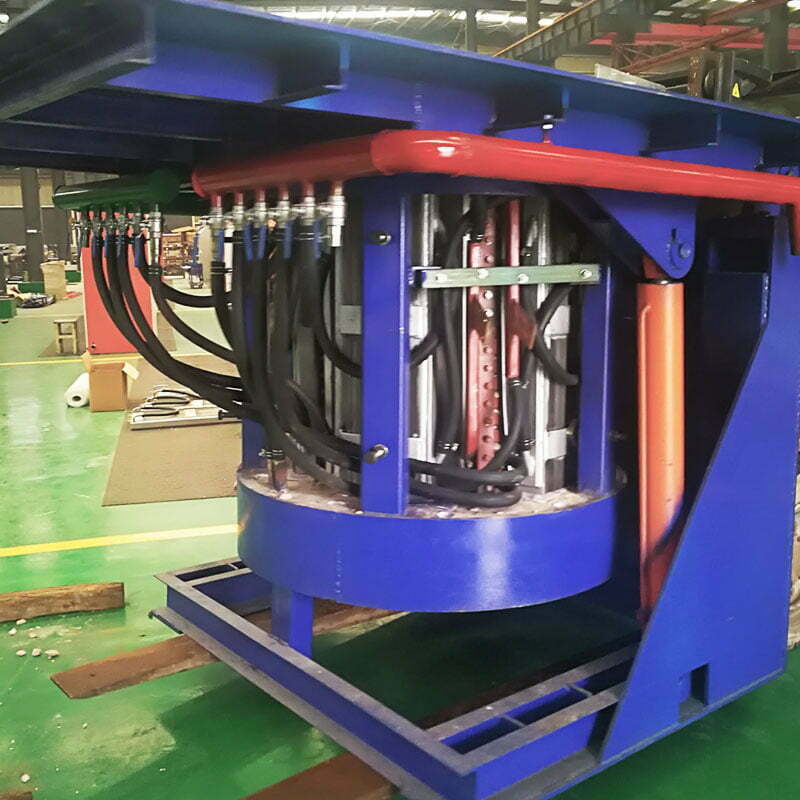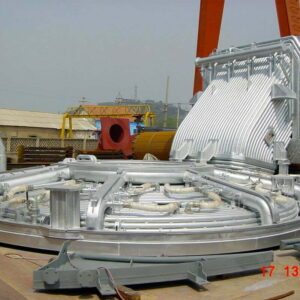Description
Coreless Induction Furnace
The coreless induction furnace is mainly composed of the furnace body, furnace frame, auxiliary device, cooling system, power supply, and control system.
Coreless induction melting furnace (non-vacuum) uses a controllable silicon static intermediate frequency power supply for induction heating, and is used for melting and heat preservation of non-ferrous metals such as copper, aluminum, and stainless steel.
Generally, according to the capacity of the furnace body, it is divided into aluminum shell structure and steel shell structure. The aluminum shell structure generally adopts the tilting furnace mode powered by the reducer (there are also a few hydraulic tilting furnaces), and the steel shell structure induction furnaces generally adopt the tilting furnace mode powered by hydraulic pressure.
Parameters
Use environment and conditions:
1. Ambient temperature 2℃~35℃;
2. The relative humidity does not exceed 90%;
3. The altitude does not exceed 1000 meters;
4. There is no conductive dust and corrosive gas around;
5. There is no danger of explosion and violent vibration around;
6. The cooling water temperature is not less than 5℃ and not more than 35℃. The outlet water temperature is not more than 55℃, the pH value of pH is within the range of 6 to 8.5, and the hardness is not more than 8 degrees (1 liter of water contains 10 mg Cao per degree);
7. The fluctuation of the three-phase power supply voltage is not more than 10%.
The main technical parameters:
1. Power supply voltage Three-phase 380V
2. Power frequency 50HZ
3. Intermediate frequency voltage 1000V
4. IF frequency 1500HZ
5. Working temperature 1600℃
6. Cooling water inlet pressure 0.15~0.2Mpa
Features
1. Safe, sturdy and efficient furnace structure
The coreless induction furnace body is designed with an anti-vibration (7 Richter standard) structure, equipped with a special structure yoke and special-shaped coil conductors to realize the safe and efficient operation of the furnace body.
2. Built-in fault detection monitor
A variety of sensors collect equipment operating data at all times, alarm in time for abnormal conditions and cut off the power supply operation, the man-machine interface automatically pops up the fault content, and guides maintenance personnel to troubleshoot and repair.
3. Compact and efficient inverter power supply
Compared with thyristor power supply, it can save 2-3% energy consumption.
Regardless of the output power, high efficiency (above 0.98) can be achieved.
Multi-pulse rectification can greatly reduce the amount of high-order harmonics, eliminating the need for high-order harmonic processing devices.
The rated power can be input from the initial stage of the cold material, and the melting time can be shortened by about 6%.
The compact power supply cabinet design of the coreless induction furnace saves land resources and reduces the customer’s initial investment cost.
4. Simple operation
Only need the “start”, and “stop” switch and power adjustment knob to complete the operation. Supplemented with the large-screen humanized man-machine interface, automatic sintering, automatic preheating, fault management analysis, data export and other functions, it provides support for factory automation production.
5. High reliability of electronic components
The inverter electronic components adopt IGBT modules, and each module of the coreless induction furnace undergoes strict temperature changes and vibration tests before leaving the factory. The inverter is composed of several unit groups, which can realize selective partial shutdown operations and reduce downtime in the event of a fault.
Service
What we can do:
Complete coreless induction furnace solutions including design, production line setup, and workshop layout according to customer’s requirements.
Experienced technical engineers commit to producing and installing high-quality coreless induction furnaces and auxiliary equipment /spare parts.
Technical services and after-sale technical support.
Also can adjust the production line or develop and improve the capacity based on the user’s existing production line with professional engineers available for overseas installation guide and maintenance.








